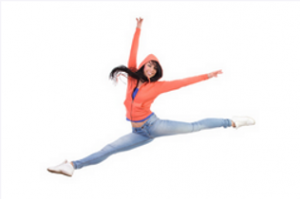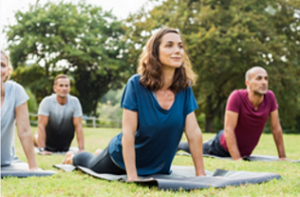The benefits of stretching exercises for flexibility are well documented. Stretching is not some fad. It is legitimately recognized as a superior form of treatment for sore muscles, contracted tendons, bad posture, repetitive syndromes, and the many forms of bursitis.
Stretching is recommended by health care professionals after certain surgeries. It is an absolute necessity for athletes, and there is an upward trend of employers creating stretching programs for the relief of workplace aches and pains.
Further, employees with jobs that require heavy lifting find warm-up and cool-down exercises help their psychological state by energizing and motivating them, as well as preparing their bodies for the strenuous day ahead.
Every age bracket blossoms from stretching and improving mobility. Flexible range of motion makes life more enjoyable because all of us can take pleasure in our hobbies and pastimes.
Wouldn’t it be wonderful if we didn’t have to moan and groan about how stiff our bodies are?
Now, we are not proposing that stretches are the cure-all for every ailment, but we are saying that they can certainly help with our more sedentary lifestyle.
Many people would say they are very active because they have plenty of running around to do, deadlines to meet, places to be, and so on.
The truth is that is not light physical activity. None of that really helps to make our bodies flexible, and none of that builds much strength in bones and joints.
Yes, many lives are hectic, but that does not equate to exercise. We just don’t do much in the way of improving our flexibility.
At this point in the discussion, let’s take a look at how stretching helps your golf swing, how it improves your dance, and why hip mobility is important to your body’s mechanism.
Stretching For Better Golf Swing
Lots of people say golf is a sedentary sport. There is no action. It is like watching a pot boil.
 While it is a slow pace to watch eighteen holes at play, we disagree with the thought that it is not rigorous enough.
While it is a slow pace to watch eighteen holes at play, we disagree with the thought that it is not rigorous enough.
When you understand how flexible the body needs to be to swing for putts and long drives, those people would realize that it is actually a hard sport to do.
Of course, pros make it look easy, but that has taken them years of practice and game playing. Each stroke, each stance, and each hit is specially choreographed.
Yet, none of that can happen with tight muscles and immobile joints.
The next time the naysayers watch a game of golf, they should pay attention to the way the body is contorted to make the perfect shot.
Golf is two-fold when it comes to stretching for better golf swing rotation:
- You need to be limber to learn and play. Many muscles of the body are used for the different poses.
- The game itself provides a wonderful way to stretch. It is the perfect example of stretching exercises for flexibility.
If you play golf, whether for fun on the public course, or you have a membership at one of the clubs, stretching is recommended before the game to prevent any injuries from stiff muscles and tendons.
For those of you that live in climates where the golf season is April to October, finding a way to keep fit and limber during the winter months is important to keep up your performance when spring arrives and courses open.
In other words, maintain your stretching routine all year round, so that you are ready at a moment’s notice when the snow clears.
Since different golf swings take a lot of twisting, it makes sense to do a twisting stretch. You’ll need one that targets many parts of the body at the same time.
So stand with your legs apart, wider than your hips. Put your right arm behind your back, resting your hand on your left hip.
Bend the right knee and stretch the left arm into the air. Make sure to keep your eyes on your outstretched arm, as though you watching the ball go through the air.
Doing six of these twisting stretches on each side of the body will ensure loosened hamstrings, and flexible upper back muscles.
Stretches For Better Hip Mobility
With the hips being in the middle of the body, they are complex joints that provide strength and stability to the lower body. Without the hips, you wouldn’t be able to move your legs side to side, back and forth, or up and down.
That is why the hip joints are so large and crave stretching exercises for flexibility.
The hips, sometimes called hip flexors because of the function they perform, are comprised of five parts. Bones, muscles, cartilage, tendons, and fluid all make up this area of the body.
Thus, you can see how if one component is damaged or inflamed, it causes the whole to work improperly. You, then, are prone to accidents, and poor mobility.
Further, recovering from a broken hip is a major event. Not only does the physical recuperation take a toll, but, mental health is affected, too, since you cannot get around and do normal activities. Many people become sad to the point of depression.
It’s kind of remarkable, really, how the hips work because even the knees can become really sore if the hips aren’t in sync. You’ll be going along, wondering what you did to hurt knees, and thinking it odd that you can’t bend as far.
What has happened, in fact, is that your hips are not performing, creating problems elsewhere, making it difficult for your to determine the exact issue.
Daily exercising with stretches for better hip mobility can prevent those sore knees, and also keep you in good condition so that you can get down lower without discomfort.
Think about getting into your car. You have to get down and twist around to sit in the seat. All of these movements need the hips to flex without restriction.
Working out the hips means that you stretch to keep them loose for all-over body flexibility, and you stretch to keep them strong in order to avoid accidents to the hips themselves, and injuries to other parts of the body that rely on hip mobility.
Stretching For Better Dance
You don’t have to be a professional dancer to get your groove on and do some moves. In fact, dancing around the house is a great release of energy, and an equally marvelous way to do your daily stretches.
Dance, like golf, is another activity that is improved with consistent and regular stretching, but is also itself, a perfect way to get your stretching exercises for flexibility done in a fun and pleasant manner.
Also, like golf, flexing your hips is crucial to even the most simplistic and basic dance steps. It improves hip mobility, giving your body the support it needs to stand on one leg, turn around, and move quickly.
Another reason stretching is important is the cardio part of dancing. When our muscles are tight and unused, and we jump into a sport or activity that is fast paced, we become more tired.
We need energy for both the dance moves, and to compensate for the poorly performing muscles. It is often said that stretching is the body’s energy efficiency manager.
Additionally, the piriformis muscle, found in the buttocks, works with the hips to turn out your feet. This pose is rather pronounced for ballet dancers, but anyone that dances should strive for optimal flexibility.
Finally, remember that when you are finished dancing, if you have been practising for a competition, or taking dance lessons, or have performed in a play, be sure to finish off with your cooling down exercises.
Regardless of whether you enjoy any of the above activities, stretching is perfect for all around general fitness. To find out what type of stretching is most recommended for general fitness purposes, please see this article.
Final Thoughts on Stretching Exercises for Flexibility
While we have identified why hip mobility is essential for properly executed golf swings and fun dance steps, the truth is everyone benefits when they complete stretching exercises for flexibility.
You don’t have to be a contortionist and get your legs wrapped around your head, but you still want to feel like you can enjoy yourself doing the hobbies you love.
Whether you are a beginner or a long-time stretcher… Whether you perform professionally or just for recreation… Whether you are young or mature…
You can learn to love your daily stretches!



